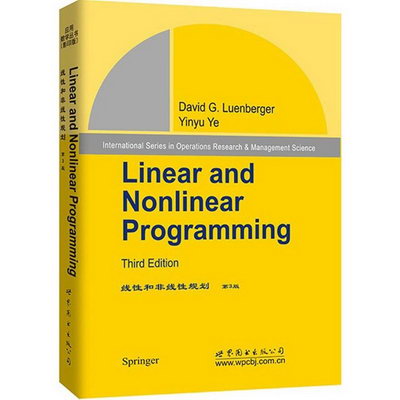
出版社:世界圖書出版公司 ISBN:9787510094736 商品編碼:1640443472 品牌:文軒 出版時間:2015-05-01 代碼:99 作者:呂恩博格(DavidG.Luenberger
" 作 者:(美)呂恩博格(David G.Luenberger) 著 著  定 價:99  出 版 社:世界圖書出版公司  出版日期:2015年05月01日  頁 數:546  裝 幀:平裝  ISBN:9787510094736   ●Chapter 1.Introduction
1.1.Optimization
1.2.Types of Problems
1.3.Size of Problems
1.4.Iterative Algorithms and Convergence
PART Ⅰ Linear Programming
Chapter 2.Basic Properties of Linear Programs
2.1.Introduction
2.2.Examples of Linear Programming Problems
2.3.Basic Solutions
2.4.The Fundamental Theorem of Linear Programming
2.5.Relations to Convety
2.6.Exercises
Chapter 3.The Simplex Method
3.1.Pivots
3.2.Adjacent Extreme Points
3.3.Determining a Minim Feasible Solution
3.4.Computational Procedure—Simplex Method
3.5.Artifi Variables
3.6.Matrix Form of the Simplex Method
3.7.The Revised Simplex Method
3.8.The Simplex Method and LU Decomition
3.9.Decomition
3.10.Summary
3.11.Exercises
Chapter 4.Duality
4.1.Dual Linear Programs
4.2.The Duality Theorem
4.3.Relations to the Simplex Procedure
4.4.Sensitivity and Complementary Slackness
4.5.The Dual Simplex Method
4.6.The—Primal—Dual Algorithm
4.7.Reduction of Linear Inequalities
4.8.Exercises
Chapter 5.Interior—Point Methods
5.1.Elements of Complety Theory
5.2.The Simplex Method is not Polynomial—Time
5.3.The Ellipsoid Method
5.4.The Analytic Center
5.5.The Central Path
5.6.Solution Strategies
5.7.Termination and Initialization
5.8.Summary
5.9.Exercises
Chapter 6.Transportation and Network Flow Problems
6.1.The Transportation Problem
6.2.Finding a Basic Feasible Solution
6.3.Basis Triangularity
.Simplex Method for Transportation Problems
6.5.The Assignment Problem
6.6.Basic Network Concepts
6.7.Minim Cost Flow
6.8.Mamal Flow
6.9.Summary
6.10.Exercises
PART Ⅱ Unconstrained Problems
Chapter 7.Basic Properties of Solutions and Algorithms
7.1.First—Order Necessary Conditions
7.2.Examples of Unconstrained Problems
7.3.Second—Order Conditions
7.4.Convex and Concave Functions
7.5.Minimization and Mamization of Convex Functions
7.6.Zero—Order Conditions
7.7.Global Convergence of Descent Algorithms
7.8.Speed of Convergence
7.9.Summary
7.10.Exercises
Chapter 8.Basic Descent Methods
8.1.Fibonacci and Golden Section Search
8.2.Line Search by Curve Fitting
8.3.Global Convergence of Curve Fitting
8.4.Closedness of Line Search Algorithms
8.5.Inaccurate Line Search
8.6.The Method of Steepest Descent
8.7.Applications of the Theory
8.8.Newton's Method
8.9.Coordinate Descent Methods
8.10.Spacer Steps
8.11.Summary
8.12.Exercises
Chapter 9.Conjugate Direction Methods
9.1.Conjugate Directions
9.2.Descent Properties of the Conjugate Direction Method
9.3.The Conjugate Gradient Method
9.4.The C—G Method as an Optimal Process
9.5.The Partial Conjugate Gradient Method
9.6.Extension to Nonquadratic Problems
9.7.Parallel Tangents
9.8.Exercises
Chapter 10.Quasi—Newton Methods
10.1.Modified Newton Method
10.2.Construction of the Inverse
10.3.Davidon—Fletcher—Powell Method
10.4.The Broyden Family
10.5.Convergence Properties
10.6.Scaling
10.7.Memoryless Quasi—Newton Methods
10.8.Combination of Steepest Descent and Newton's Method
10.9.Summary
10.10.Exercises
PART Ⅲ Constrained Minimization
Chapter 11.Constrained Minimization Conditions
1.1.Constraints
1.2.Tangent Plane
1.3.First—Order Necessary Conditions(Equality Constraints)
1.4.Examples
1.5.Second—Order Conditions
1.6.Eigenvalues in Tangent Subspace
1.7.Sensitivity
1.8.Inequality Constraints
1.9.Zero—Order Conditions and Lagrange ltipliers
1.10.Summary
1.11.Exercises
Chapter 12.Primal Methods
12.1.Advantage of Primal Methods
12.2.Feasible Direction Methods
12.3.Active Set Methods
12.4.The Gradient Projection Method
12.5.Convergence Rate of the Gradient Projection Method
12.6.The Reduced Gradient Method
12.7.Convergence Rate of the Reduced Gradient Method
12.8.Variations
12.9.Summary
12.10.Exercises
Chapter 13.Penalty and Barrier Methods
13.1.Penalty Methods
13.2.Barrier Methods
13.3.Properties of Penalty and Barrier Functions
13.4.Newton's Method and Penalty Functions
13.5.Conjugate Gradients and Penalty Methods
13.6.Normalization of Penalty Functions
13.7.Penalty Functions and Gradient Projection
13.8.Exact Penalty Functions
13.9.Summary
13.10.Exercises
Chapter 14.Dual and Cutting Plane Methods
14.1.Global Duality
14.2.Local Duality
14.3.Dual Canonical Convergence Rate
14.4.Separable Problems
14.5.Augmented Lagrangians
14.6.The Dual Viewpoint
14.7.Cutting Plane Methods
14.8.Kelley's Convex Cutting Plane Algorithm
14.9.Modifications
14.10.Exercises
Chapter 15.Primal—Dual Methods
15.1.The Standard Problem
15.2.Strategies
15.3.A Simple Merit Function
15.4.Basic Primal—Dual Methods
15.5.Modified Newton Methods
15.6.Descent Properties
15.7.Rate of Convergence
15.8.Interior Point Methods
15.9.Semidefinite Programming
15.10.Summary
15.11.Exercises
Appendix A.Mathematical Review
A.1.Sets
A.2.Matrix Notation
A.3.Spaces
A.4.Eigenvalues and Quadratic Forms
.Topological Concepts
A.6.Functions
Appendix B.Convex Sets
B.1.Basic Definitions
B.2.Hyperplanes and Polytopes
B.3.Separating and Supporting Hyperplanes
B.4.Extreme Points
Appendix C.Gaussian Elimination
Bibliography
Index  這部研究運籌學的經典教材,在原來版本的基本上做了大量的修訂補充,涵蓋了這個運算領域的大量的理論洞見,是各行各業分析學者和運籌學研究人員所必需的。書中將運籌問題的純分析特性和解決其的算術行為聯繫起來,將新鮮的運籌學方法包括其中。目次:導論;(線性規劃):線性規劃的基本性質;單純型方法;對偶;內部點方法;運輸和網絡流問題;(無條件問題)解的基本特性和運算;基本下降方法;共軛方向法;擬牛頓法;(條件小化)條件小化條件;原始方法;懲罰和柱式開采法;對偶和割平面方法;原始對偶方法;附錄A:數學回顧;凸集合;高斯估計。
讀者對像:數學、特別是運籌學專業的高年級本科生、研究生和工程人員。  (美)呂恩博格(David G.Luenberger) 著 著 David G.Luenberger(D.G.呂恩博格,美國)是GUO際學者,在數學和物理學界享有盛譽。本書凝聚了作者多年科研和教學成果,適用於科研工作者、高校教師和研究生。 
" | 



